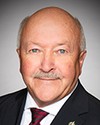Sure.
Beyond Preclearance was started about a year and a half ago. It's co-chaired by the Vancouver Airport Authority and the Pacific NorthWest Economic Region on the other side of the border. It has members in Canada and the U.S.—various organizations and companies—and it's basically built around taking what we had with Beyond the Border and figuring out what the next evolution is of Canada-U.S. border policy.
Both Canada and the U.S. are going to be under immense resource requirements to meet future volumes. This is in terms of hiring tens of thousands of new border agents and having significantly higher volumes to deal with at the border. That's a big problem for all of our members who are already facing, in many cases, significant delays and challenges in getting their good and services through the border.
Beyond Preclearance put out a white paper last year that lays out, across all four modes, what the future of border crossing could look like. This is about how you take new technology, such as biometrics, remote and multi-use screening, and potential issues like blockchain, to start clearing carriers as far away from the border as possible—away from where.... Imagine a crate that is unloaded in the port of Vancouver. If you could clear it in a way that both the Canadian and American border agents could track it and assume that it is cleared and, therefore, can pass seamlessly through the Canada-U.S. border....
What the white paper has done.... The subsequent work that the coalition has been doing is designing pilot projects, in co-operation with Public Safety, CBSA, CBP and DHS, to imagine what these borders of the future would look like and to start pilot-testing those issues now so that we can figure out what the technology is and what the investments will be to keep the border not only safe and secure, but also more efficient.
It's a really good piece of work that we would highly recommend the committee consider in its strategy.




